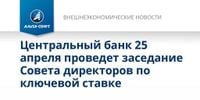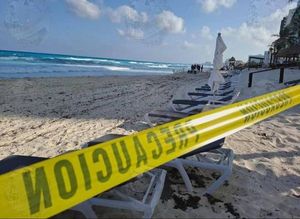The Bank of Russia's Board of Directors decided at its meeting on April 25, 2025, to maintain the key interest rate at 21%. This decision was anticipated by 20 out of 21 economists surveyed in a consensus forecast by Vedomosti. This marks the fourth consecutive meeting where the Central Bank has kept the rate stable, a level that has remained unchanged since October of the previous year.
In a press release following the meeting, the Bank noted that while current inflationary pressure continues to decline, it remains high. Furthermore, internal demand is growing at a rate that significantly outpaces the supply of goods and services. The Central Bank emphasized the need to maintain tight monetary conditions to achieve the inflation target of 4% by 2026.
Interestingly, the latest release from the Bank of Russia did not include previous warnings that it might consider raising the key rate if disinflation dynamics do not ensure the target is achieved. This indicates a shift in the Bank's tone, suggesting a more cautious approach moving forward.
Operational data from Rosstat revealed that the consumer price index for the week ending April 21 was 0.09%, a slight decrease from 0.11% and 0.16% in the preceding weeks. Annual inflation, calculated according to the methodology adhered to by the Central Bank, remained steady at 10.34% as of April 21, unchanged from the previous week.
However, the Ministry of Economic Development recently raised its inflation forecast for 2025 from 4.5% to 7.6%, reflecting the ongoing economic challenges. Analysts surveyed by the Bank of Russia have also slightly adjusted their inflation expectations for the end of 2025, now predicting it will reach 7.1% instead of 7% as previously thought.
Elvira Nabiullina, the head of the Bank of Russia, previously warned of 'painful consequences' if the key rate were to be reduced without addressing the underlying high inflation. "It is naive to believe that the key rate is such a magic wand," she stated, emphasizing that lowering the rate could lead to a resurgence of prices and a further increase in market rates.
Despite high interest rates, Nabiullina noted that business is still developing dynamically. She clarified that the Central Bank's goal was not to freeze lending, but rather to approach any potential rate cuts with caution, considering the lessons learned from the previous year when inflation initially slowed but then surged again, prompting a hike in the rate from 16% to 21%.
In the State Duma, there was disappointment regarding the Central Bank's decision to maintain the key rate. Svetlana Razvorotneva, deputy head of the Duma’s committee on construction and housing, expressed concern that the ongoing high rate would create various problems, particularly in mortgage lending and public utilities.
Looking ahead, analysts are divided on when the Central Bank might begin to lower the key rate. Some predict that easing could start as early as this summer, with possible reductions in July by 100 to 200 basis points, while others suggest a more likely timeline would be in September.
For instance, Mikhail Vasiliev, chief analyst at Sovcombank, noted that if inflation dynamics continue to improve, particularly in a sustainable manner, the easing cycle of monetary policy could begin in the third quarter of 2025. Meanwhile, Andrey Kostin, head of VTB, indicated that the key rate might end the year at around 19% to 19.5% if annual inflation remains below 8%.
In terms of the broader economic outlook, both internal and external factors are increasing pressure on the Russian economy, which in turn affects interest rates. Experts from various financial institutions have pointed out that a strong ruble, slow economic cooling, and ongoing labor market tensions are all contributing to the current economic climate.
During a recent video conference, Dmitry Pyanov, First Deputy Head of VTB Management, likened the high key rate to using an experimental antibiotic, suggesting that premature reductions could lead to adverse effects, including a resurgence of inflation. He highlighted the need for sustained evidence of positive economic trends before considering any rate cuts.
As the Bank of Russia navigates these economic challenges, it remains to be seen how its policies will evolve in response to both domestic conditions and external uncertainties. The delicate balance of fostering economic growth while controlling inflation will likely dictate the Central Bank's decisions in the coming months.
In conclusion, the decision to maintain the key rate at 21% reflects the Bank of Russia's cautious approach in a complex economic environment. As inflationary pressures persist and the demand-supply imbalance continues, the Central Bank's future actions will be closely monitored by economists and policymakers alike.






